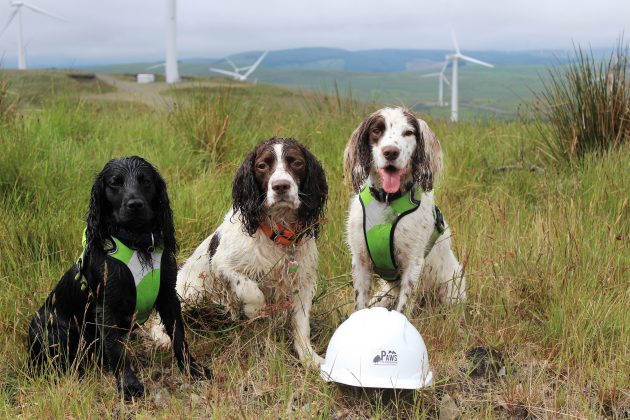David Tomlinson learns how teams of sporting spaniels are helping to protect some of Britain’s most endangered species by doing what they do best – detecting scent
Many sporting dogs are helping with conservation and helping to protect endangered species such as bats and water voles in the UK. Earlier this winter, I was walking my spaniel along a footpath when she stopped as suddenly as if she had run into a brick wall. There was no visual barrier – she had clearly run into strong scent. Sure enough, an impressive covey of 15 grey partridges lifted from the cover crop in the adjoining field. They were at least 150 yards away. Perhaps they had recently crossed the path but, even if they had, it was a reminder of the extraordinary scenting abilities of a working-bred gundog.
THE SPORTING DOGS HELPING TO PROTECT ENDANGERED SPECIES

It’s no wonder that spaniels can register scent that is far beyond our own capabilities. Dogs have more than 100 million sensory receptor sites in their nasal cavity, compared with the measly six million or so that we have. What’s more, the area of the canine brain that specialises in analysing scents is around 40 times bigger than the comparable part of the human brain. It’s hardly surprising that dogs can smell things that are beyond our capacity to detect. Of course, all dogs have similar scenting abilities but it seems that gundogs are best at interpreting them.
This explains why labradors and spaniels are so popular as drug-detection dogs. There are other reasons, too. One of which is their trainability. Spaniels also score highly because they are seen as friendly, unthreatening dogs. A rottweiler or dobermann might work equally well, but most people find such breeds far more intimidating than a spaniel. Spaniels have other advantages, too. A police dog handler once told me that it’s easy to pick up a cocker to check the overhead compartments in an aeroplane, for example, but that’s not something you can do with one of the larger breeds.
We have long had drug-and explosive-detection dogs, but their use in practical wildlife conservation is a more recent development. Five years ago I spent a fascinating morning with Ali Charnick, an ecologist with a BSc in Conservation and Environment. We were walking along a tributary of the Stour, looking for water voles. We didn’t see any – water voles can be remarkably elusive – but her spaniels detected their presence.
Though water vole droppings might be odourless to us, they are packed full of scent. Charnick had trained her working-bred spaniels – a springer and a sprocker – to locate water vole latrines, finding evidence of the secretive creatures in places where no human had succeeded. Voles will typically leave latrines in secluded areas where it is almost impossible for two-legged searchers to go but which pose no problem to water-loving spaniels.
Locating remnant populations of water voles is key to ensure their survival, for no British mammal has suffered such a catastrophic decline. Once widely distributed throughout mainland Britain, they have undergone a site loss of 94% and become a highly endangered species. Water voles evolved in a mink-free environment but struggle to survive alongside such a voracious predator. If a vole population is discovered, then it makes sense to employ mink rafts. Mink are relatively easy to trap, and the proven presence of water voles gives the incentive to land managers and wildlife trusts to put the effort into trapping the invasive animals.
Many rural developments require surveys for great crested newts before planning can be granted. Seeking out this endangered species is one of the many accomplishments of the Paws for Conservation spaniels. The company was started in 2020 by professional dog trainer Rachael Flavell. She soon found that she had more work than she could cope with, so in 2021 she was joined by fellow dog handler and trainer Aran Clyne. Between them they employ a team of six dogs – all either cockers or English springers, except for Nala: a springer-collie cross. Intriguingly, most of the team are rescue dogs. High-energy canines with a strong hunting drive are essential for this kind of work, attributes that can make such animals unsuitable as pets. Training is based on a simple reward system using tennis balls.
Apart from great crested newts, the Paws for Conservation team’s speciality is finding bat and bird carcasses under wind farms. If deaths are to be avoided, it’s essential to know which, and when, individual turbines are most lethal. A typical day checking under wind turbines will start at dawn, before most scavengers have cleaned up, and will involve two dogs, with one resting as the other works.
Flavell explains why they are so good at the job. “Dogs are non-invasive, more efficient and cover areas far more quickly than human search teams, thus saving time and money. They do not assume or discriminate like a human, making them an effective tool in assisting with surveys. Some of the finds my dogs have had over the years would have been near impossible for a human to see. The potential uses of conservation dogs extends far beyond birds, bats, voles and newts. For example, our dogs will also detect the presence of pine martens, one of the most elusive of animals. Internationally, using dogs to detect ivory, or pangolin scales, has the potential to have a huge impact on the illegal wildlife trade.” As an owner of a sporting spaniel, I’m not in the least bit surprised to find that hi-tech has no match for a canine nose.




